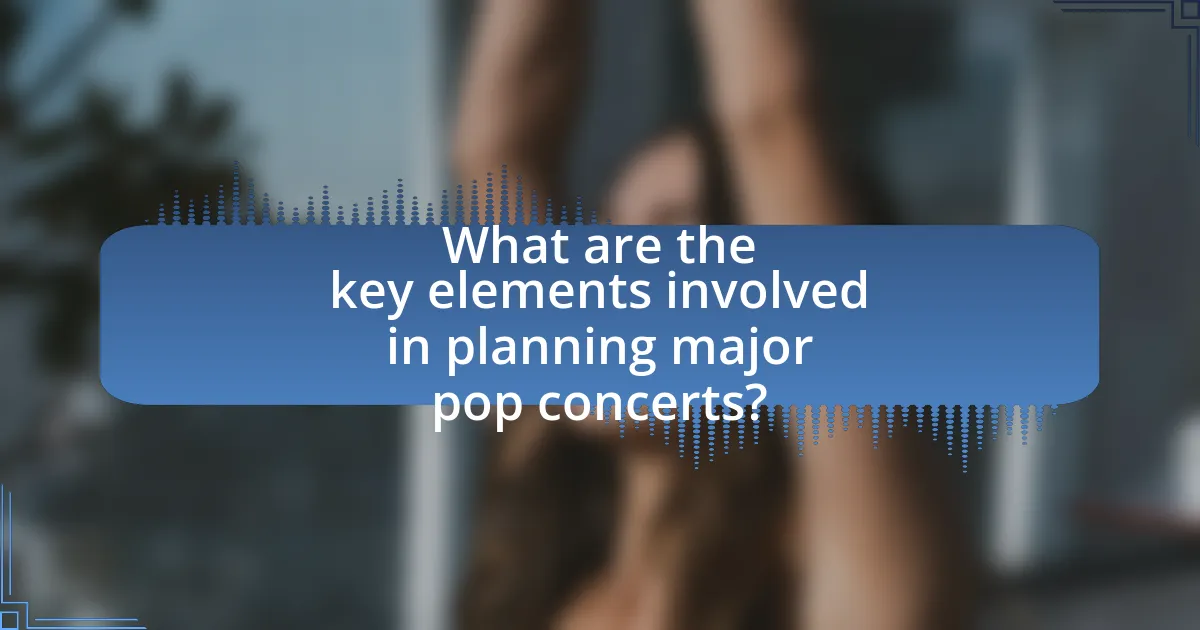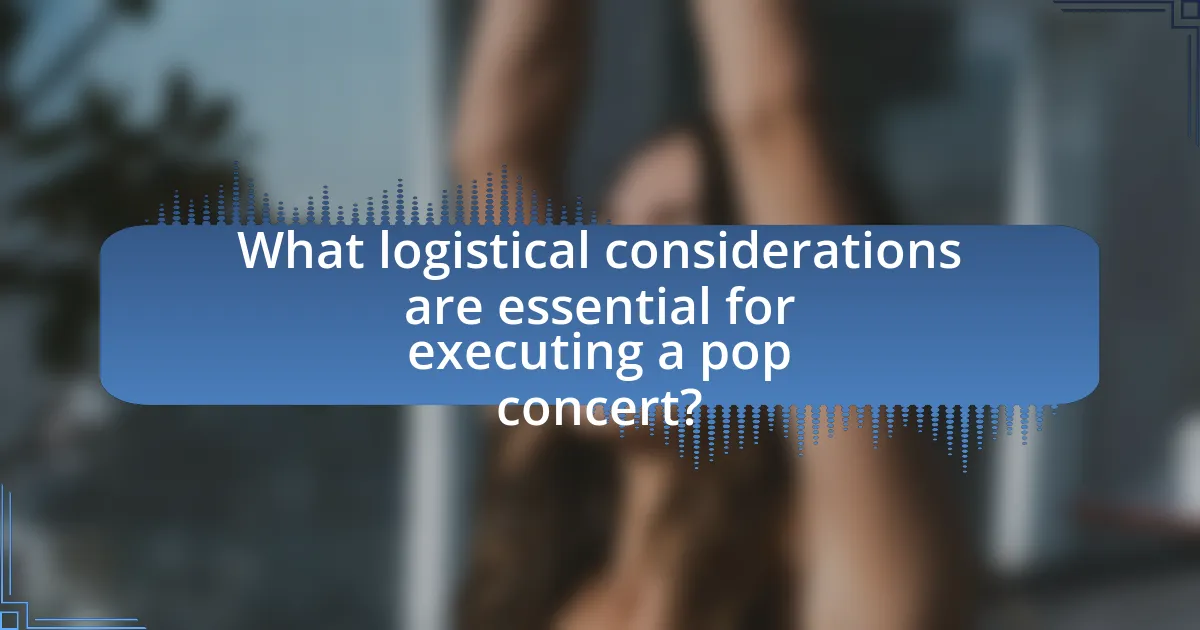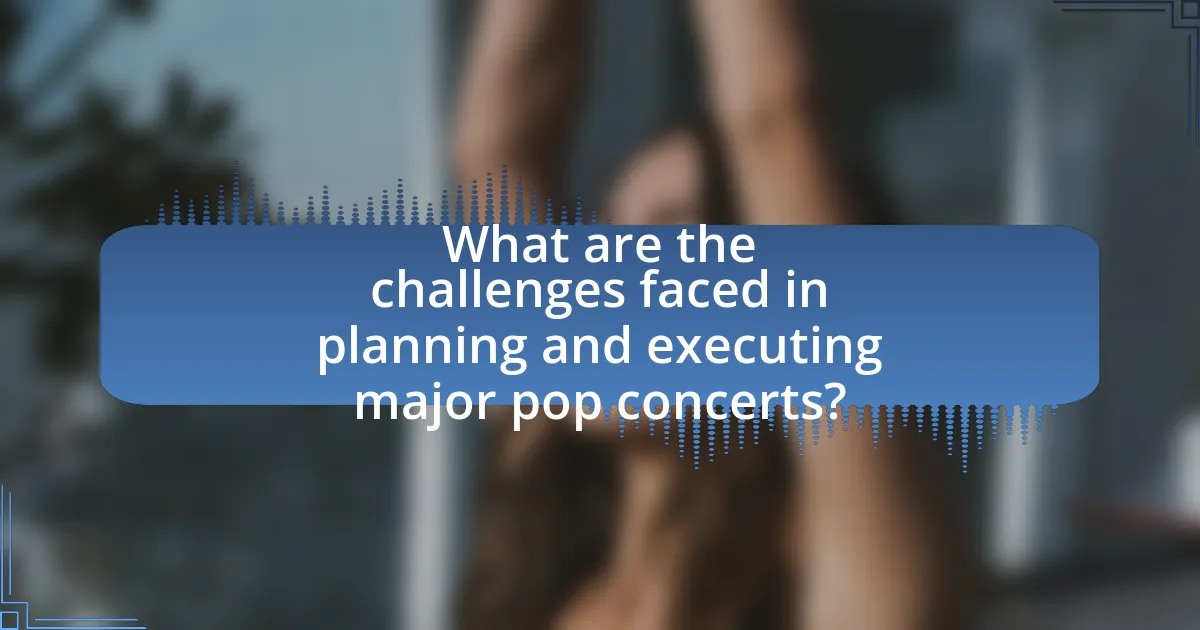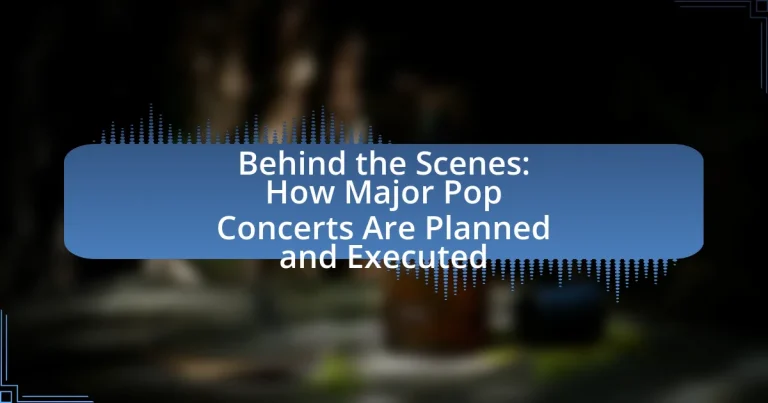The article focuses on the intricate planning and execution of major pop concerts, detailing essential elements such as venue selection, artist booking, logistics management, marketing strategies, and production design. It examines how concert promoters choose venues based on capacity, location, and acoustics, and highlights the significant role of artists and their management in shaping the concert experience. Additionally, the article addresses budget management, logistical challenges, safety measures, and the impact of weather on outdoor events. By analyzing past concert failures and successful practices, it provides insights into effective planning and communication strategies that enhance audience engagement and ensure a successful concert experience.

What are the key elements involved in planning major pop concerts?
The key elements involved in planning major pop concerts include venue selection, artist booking, logistics management, marketing strategies, and production design. Venue selection is critical as it determines capacity, location, and accessibility, impacting ticket sales and audience experience. Artist booking involves negotiating contracts and ensuring availability, which is essential for attracting fans. Logistics management encompasses transportation, accommodation, and scheduling, ensuring smooth operations on the concert day. Marketing strategies are vital for promoting the event, utilizing social media, traditional advertising, and partnerships to maximize reach. Finally, production design includes stage setup, sound, lighting, and visual effects, which enhance the overall concert experience and align with the artist’s vision. Each of these elements must be meticulously coordinated to ensure a successful event.
How do concert promoters select the venue for a pop concert?
Concert promoters select the venue for a pop concert based on factors such as location, capacity, and logistical considerations. They prioritize venues that are easily accessible to the target audience, ensuring high attendance rates. Capacity is crucial, as promoters aim to match the venue size with expected ticket sales to maximize revenue while avoiding under or over-selling. Additionally, logistical aspects like stage setup, sound quality, and available amenities influence the decision. Historical data on past events at specific venues can also guide promoters in making informed choices, as successful previous concerts can indicate a venue’s suitability for future events.
What factors influence the choice of venue for a major concert?
The choice of venue for a major concert is influenced by several key factors, including capacity, location, acoustics, and logistical considerations. Capacity is crucial as it determines the number of attendees and potential revenue; for instance, venues like Madison Square Garden can accommodate around 20,000 people, maximizing ticket sales. Location affects accessibility for fans and artists; venues situated in urban areas often attract larger crowds due to convenience. Acoustics play a significant role in the overall concert experience, as venues with superior sound quality enhance audience satisfaction. Logistical considerations, such as availability of parking, transportation options, and technical facilities, also impact the decision-making process, ensuring that the concert runs smoothly.
How does venue capacity affect ticket sales and audience experience?
Venue capacity directly influences ticket sales and audience experience by determining the number of tickets available and the overall atmosphere of the event. Larger venues can accommodate more attendees, potentially leading to higher ticket sales due to increased demand; for instance, a stadium with a capacity of 50,000 can sell more tickets than a theater with a capacity of 2,000. However, if a venue is too large for the expected audience, it may create a sparse atmosphere, negatively impacting the audience’s experience. Conversely, smaller venues can foster intimacy and engagement, enhancing the overall enjoyment for attendees. Research indicates that audience satisfaction often correlates with venue size, as a well-filled smaller venue can create a more vibrant and connected experience compared to a half-empty larger venue.
What role do artists and their management play in concert planning?
Artists and their management play a crucial role in concert planning by overseeing the creative vision and logistical execution of the event. The artist defines the performance elements, including setlist, staging, and overall artistic direction, while management coordinates contracts, budgets, and schedules. For example, management negotiates with venues and promoters to secure dates and ensure that the artist’s requirements are met, such as technical specifications and hospitality needs. This collaboration ensures that the concert aligns with the artist’s brand and engages the audience effectively, ultimately contributing to the event’s success.
How do artists’ preferences shape the concert experience?
Artists’ preferences significantly shape the concert experience by influencing setlists, stage design, and overall performance style. For instance, an artist’s choice of songs directly affects audience engagement and emotional response, as seen in studies where setlist variations led to different levels of audience excitement and participation. Additionally, preferences regarding visual elements, such as lighting and stage layout, create a unique atmosphere that aligns with the artist’s brand and artistic vision, enhancing the overall experience for attendees. This alignment between artist preferences and concert execution is crucial for delivering a memorable performance that resonates with fans.
What are the contractual obligations between artists and promoters?
The contractual obligations between artists and promoters typically include performance terms, payment details, and logistical responsibilities. Artists are obligated to perform at the agreed-upon date and venue, while promoters must ensure that the venue is suitable and that all necessary permits are obtained. Payment obligations often specify the artist’s fee, payment schedule, and any additional expenses covered by the promoter, such as travel and accommodation. These contracts also outline responsibilities for marketing and promotion of the event, ensuring both parties fulfill their roles to achieve a successful concert.
How is the concert budget determined and managed?
The concert budget is determined by estimating all potential costs associated with the event, including venue rental, artist fees, production expenses, marketing, and staffing. Event organizers analyze historical data from previous concerts, industry standards, and specific requirements of the artists to create a comprehensive budget.
Management of the budget involves continuous monitoring of expenses against the projected costs throughout the planning and execution phases. This includes tracking ticket sales, adjusting marketing strategies, and reallocating funds as necessary to ensure financial viability. For example, a successful concert may see ticket sales exceeding projections, allowing for additional investments in production quality or marketing efforts.
What are the major cost components in a concert budget?
The major cost components in a concert budget include venue rental, artist fees, production costs, staffing, marketing, and equipment rental. Venue rental typically represents a significant portion of the budget, often ranging from thousands to millions of dollars depending on the location and capacity. Artist fees encompass payments to performers, which can vary widely based on their popularity and demand. Production costs involve expenses for staging, lighting, sound systems, and special effects, which are crucial for creating the concert experience. Staffing costs cover wages for security, ticketing, and event management personnel. Marketing expenses are necessary for promoting the concert, including advertising and promotional materials. Lastly, equipment rental costs pertain to the temporary acquisition of necessary gear for the event. Each of these components plays a critical role in determining the overall financial feasibility and success of a concert.
How do promoters ensure profitability while managing expenses?
Promoters ensure profitability while managing expenses by meticulously budgeting and negotiating contracts with artists and vendors. They analyze projected revenues from ticket sales, merchandise, and sponsorships against fixed and variable costs, allowing them to identify areas for cost reduction. For instance, a study by the International Ticketing Association indicates that effective negotiation can reduce artist fees by up to 20%, significantly impacting overall profitability. Additionally, promoters often utilize data analytics to forecast attendance and optimize pricing strategies, ensuring maximum revenue generation while keeping expenses in check.

What logistical considerations are essential for executing a pop concert?
Essential logistical considerations for executing a pop concert include venue selection, equipment rental, transportation, staffing, and security. Venue selection involves assessing capacity, location, and accessibility, which directly impacts audience turnout and experience. Equipment rental encompasses sound systems, lighting, and staging, crucial for delivering a high-quality performance. Transportation logistics ensure timely arrival of artists, crew, and equipment, minimizing delays. Staffing considerations involve hiring qualified personnel for various roles, including technical support, event management, and customer service, which are vital for smooth operations. Lastly, security measures must be implemented to ensure the safety of attendees and performers, often requiring coordination with local law enforcement and private security firms. These elements collectively contribute to the successful execution of a pop concert.
How is the production team organized for a major concert?
The production team for a major concert is organized into several key roles, including a production manager, stage manager, technical director, and various crew members specializing in sound, lighting, and video. The production manager oversees the entire operation, ensuring that all elements are coordinated and executed on schedule. The stage manager is responsible for the logistics on-site, managing the flow of the show and communicating with performers and crew. The technical director supervises the technical aspects, including sound and lighting setups, while specialized crew members handle specific tasks such as rigging, sound mixing, and video production. This structured organization allows for efficient collaboration and execution, which is critical for the success of large-scale events.
What roles do sound, lighting, and stage design teams play?
Sound, lighting, and stage design teams are essential for creating the overall atmosphere and experience of a concert. The sound team is responsible for ensuring high-quality audio, including mixing and balancing live vocals and instruments, which is crucial for audience engagement. The lighting team designs and operates lighting effects that enhance the visual impact of performances, using techniques such as color, intensity, and movement to complement the music. The stage design team creates the physical layout and visual elements of the performance space, including backdrops and props, which contribute to the thematic storytelling of the concert. Together, these teams collaborate to ensure that all technical aspects align with the artistic vision, ultimately enhancing the audience’s experience.
How does effective communication among teams impact concert success?
Effective communication among teams significantly enhances concert success by ensuring that all members are aligned on goals, responsibilities, and timelines. When teams communicate effectively, they can coordinate logistics, manage schedules, and address issues promptly, which minimizes errors and delays. For instance, a study by the Project Management Institute found that organizations with effective communication practices are 50% more likely to complete projects on time and within budget. This correlation highlights how clear communication directly contributes to the smooth execution of concert elements, from stage setup to artist performance, ultimately leading to a successful event.
What safety measures are implemented during concert planning and execution?
Safety measures implemented during concert planning and execution include comprehensive risk assessments, crowd management strategies, and emergency response protocols. Risk assessments identify potential hazards such as structural integrity of the venue, weather conditions, and equipment safety. Crowd management strategies involve controlling audience flow, ensuring adequate exits, and employing trained security personnel to monitor the crowd. Emergency response protocols outline procedures for medical emergencies, evacuations, and communication plans, often involving collaboration with local law enforcement and emergency services. These measures are essential to minimize risks and ensure the safety of attendees, staff, and performers during the event.
How do security protocols protect attendees and performers?
Security protocols protect attendees and performers by implementing measures that ensure safety and mitigate risks during events. These protocols include thorough screening processes, such as bag checks and metal detectors, which prevent weapons and prohibited items from entering the venue. Additionally, trained security personnel monitor crowd behavior and manage access control to restricted areas, reducing the likelihood of incidents.
For instance, the use of surveillance cameras and communication systems allows for real-time monitoring and quick response to any potential threats. According to a report by the International Association of Venue Managers, effective security measures can decrease the risk of violence and enhance the overall safety of large gatherings.
What emergency plans are in place for unexpected situations?
Emergency plans for unexpected situations at major pop concerts include comprehensive risk assessments, designated evacuation routes, and trained medical personnel on-site. These plans are developed through collaboration with local authorities and emergency services to ensure rapid response to incidents such as medical emergencies, severe weather, or security threats. For instance, the implementation of crowd management strategies and communication protocols is critical, as evidenced by the protocols established during large-scale events like the Coachella Valley Music and Arts Festival, which has a detailed emergency response plan that includes coordination with law enforcement and medical teams.
How is the audience experience enhanced during a concert?
The audience experience during a concert is enhanced through a combination of high-quality sound, engaging visual effects, and interactive elements. High-quality sound systems ensure that every note and lyric is delivered clearly, which is crucial for audience enjoyment. Engaging visual effects, such as dynamic lighting and video displays, create an immersive atmosphere that captivates attendees. Interactive elements, like audience participation through sing-alongs or mobile app engagement, foster a sense of connection between the performers and the audience. These enhancements are supported by industry standards, such as the use of advanced audio technology and stage design principles, which are integral to the planning and execution of major pop concerts.
What technologies are used to engage the audience during performances?
Technologies used to engage the audience during performances include interactive lighting systems, augmented reality (AR), virtual reality (VR), and mobile applications. Interactive lighting systems enhance the visual experience by synchronizing lights with music, creating an immersive atmosphere. Augmented reality and virtual reality technologies allow audiences to experience performances in innovative ways, such as through 3D visuals or interactive elements that can be accessed via smartphones or VR headsets. Mobile applications facilitate audience participation by enabling real-time voting, song requests, and social media interaction, thereby increasing engagement and connection with the performance. These technologies have been widely adopted in major pop concerts to enhance the overall experience and foster a deeper connection between artists and their audiences.
How do pre-show and post-show activities contribute to the overall experience?
Pre-show and post-show activities significantly enhance the overall experience of a concert by engaging the audience before and after the main event. Pre-show activities, such as interactive installations, merchandise sales, and meet-and-greet opportunities, create excitement and anticipation, fostering a sense of community among attendees. For instance, studies show that interactive experiences can increase audience satisfaction by up to 30%. Post-show activities, including fan interactions, social media engagement, and after-parties, allow attendees to reflect on their experience, share memories, and extend the enjoyment of the event. This engagement can lead to increased loyalty and future attendance, as evidenced by a survey indicating that 70% of concert-goers are more likely to return for future events when they feel connected to the experience.

What are the challenges faced in planning and executing major pop concerts?
Planning and executing major pop concerts involves several challenges, including logistical coordination, budget management, and security concerns. Logistical coordination requires the synchronization of multiple elements such as venue selection, stage design, and equipment transportation, which can be complex and time-consuming. Budget management is critical, as costs can escalate quickly due to artist fees, production expenses, and unforeseen circumstances, necessitating careful financial planning. Security concerns are paramount, as large crowds pose risks that require comprehensive safety measures, including crowd control and emergency response planning. These challenges are supported by industry reports indicating that over 70% of concert organizers cite logistical issues as a primary concern, while security incidents have led to increased scrutiny and regulations in event planning.
How do weather conditions impact outdoor concerts?
Weather conditions significantly impact outdoor concerts by influencing attendance, safety, and overall experience. For instance, adverse weather such as rain or extreme heat can deter attendees, leading to lower ticket sales and reduced audience size. Additionally, safety concerns arise during severe weather events, prompting event organizers to implement contingency plans, which may include delays or cancellations. Historical data shows that concerts held during inclement weather often experience logistical challenges, such as equipment damage and increased operational costs. For example, a study by the National Oceanic and Atmospheric Administration indicates that concerts scheduled during thunderstorms face a higher likelihood of disruption, affecting both performers and attendees.
What contingency plans are necessary for inclement weather?
Contingency plans necessary for inclement weather during major pop concerts include establishing a clear communication protocol, securing alternative venues, and implementing safety measures for attendees. Effective communication ensures that all staff, artists, and attendees are informed of any changes or safety protocols. Securing alternative venues allows for the event to continue in case of severe weather, as seen in instances where outdoor concerts have been moved indoors due to rain or storms. Additionally, safety measures such as providing shelter, medical assistance, and evacuation plans are critical to protect attendees from potential hazards associated with inclement weather. These plans are validated by industry standards and past concert management practices, which emphasize the importance of preparedness in ensuring the safety and enjoyment of concert-goers.
How do promoters assess weather risks before the event?
Promoters assess weather risks before an event by utilizing advanced meteorological data and forecasting tools. They analyze weather patterns, historical climate data, and real-time forecasts to predict potential weather-related disruptions. For instance, they often consult services like the National Weather Service or private meteorological firms that provide detailed reports on temperature, precipitation, and severe weather alerts. This data allows promoters to make informed decisions regarding event scheduling, venue selection, and contingency plans, ensuring the safety of attendees and the success of the event.
What are the common logistical challenges encountered during concert execution?
Common logistical challenges encountered during concert execution include venue selection, equipment transportation, and crowd management. Venue selection can be complicated by factors such as capacity, accessibility, and local regulations, which can impact the overall success of the event. Equipment transportation involves coordinating the movement of sound, lighting, and staging materials, often requiring precise timing and specialized vehicles to ensure everything arrives on schedule. Crowd management is critical for safety and involves planning for entry and exit points, security measures, and emergency protocols to handle large audiences effectively. These challenges are supported by industry reports indicating that logistical issues are among the top reasons for concert delays and complications, highlighting the importance of thorough planning and execution.
How do transportation issues affect artist and equipment arrival?
Transportation issues significantly delay the arrival of artists and their equipment. When logistics such as shipping routes, vehicle breakdowns, or customs delays occur, they can hinder timely access to venues. For instance, a study by the International Live Music Conference found that 30% of concert delays are attributed to transportation problems, underscoring the critical role of efficient logistics in the live music industry.
What strategies are used to manage crowd control effectively?
Effective crowd control strategies include the use of clear communication, physical barriers, trained personnel, and technology. Clear communication ensures that attendees receive timely information about entry, exits, and safety protocols, which can significantly reduce confusion and panic. Physical barriers, such as fences and designated pathways, help direct the flow of people and prevent overcrowding in specific areas. Trained personnel, including security and event staff, are essential for monitoring crowd behavior and responding to incidents swiftly. Additionally, technology such as crowd management software and surveillance systems can provide real-time data on crowd density and movement, allowing for proactive adjustments to crowd management plans. These strategies are supported by industry practices, as seen in large-scale events like music festivals, where effective crowd management is critical for safety and enjoyment.
What lessons can be learned from past concert failures?
Lessons learned from past concert failures include the importance of thorough planning, effective communication, and risk management. For instance, the 2017 Fyre Festival, which was heavily promoted but failed to deliver on its promises, highlighted the necessity of realistic budgeting and logistical feasibility. Additionally, the 1999 Woodstock Festival faced significant issues due to inadequate infrastructure and crowd control, emphasizing the need for comprehensive safety protocols and crowd management strategies. These examples demonstrate that successful concert execution relies on meticulous preparation, clear communication among all stakeholders, and proactive risk assessment to prevent similar failures in the future.
How can promoters avoid pitfalls experienced in previous events?
Promoters can avoid pitfalls experienced in previous events by conducting thorough post-event analyses to identify weaknesses and areas for improvement. This involves reviewing feedback from attendees, staff, and stakeholders, as well as analyzing logistical challenges and financial outcomes. For instance, a study by the Event Safety Alliance highlights that understanding past incidents, such as crowd control failures or technical malfunctions, can lead to better planning and risk management strategies in future events. By implementing lessons learned, such as enhancing communication protocols and ensuring adequate staffing, promoters can significantly reduce the likelihood of repeating past mistakes.
What best practices have emerged from successful concert executions?
Best practices that have emerged from successful concert executions include meticulous planning, effective communication, and audience engagement strategies. Meticulous planning involves detailed timelines, resource allocation, and contingency plans to address potential issues, ensuring smooth operations. Effective communication among all stakeholders, including artists, crew, and venue staff, fosters collaboration and minimizes misunderstandings, which is crucial for timely execution. Audience engagement strategies, such as interactive social media campaigns and pre-show activities, enhance the overall experience and build anticipation, leading to higher attendance and satisfaction rates. These practices are supported by case studies of major concerts, such as Beyoncé’s Coachella performance in 2018, which highlighted the importance of thorough preparation and audience connection, resulting in widespread acclaim and record attendance.
What practical tips can be applied to ensure a successful concert experience?
To ensure a successful concert experience, attendees should arrive early to secure good seating and avoid last-minute stress. Arriving early allows individuals to navigate the venue, find amenities, and settle in before the performance begins. Additionally, checking the venue’s rules regarding prohibited items, such as large bags or outside food, can prevent delays at entry points. Staying hydrated and eating beforehand is crucial, as concert environments can be physically demanding. Lastly, familiarizing oneself with the concert lineup and set times enhances enjoyment by ensuring that attendees do not miss key performances. These tips are supported by industry practices that emphasize preparation and awareness for optimal concert enjoyment.
How can effective planning and communication mitigate risks?
Effective planning and communication mitigate risks by ensuring that all stakeholders are aligned and prepared for potential challenges. In the context of major pop concerts, detailed planning involves creating contingency plans for various scenarios, such as weather disruptions or technical failures. For instance, a study by the Event Safety Alliance highlights that comprehensive risk assessments and clear communication protocols significantly reduce incidents during large events. By establishing roles and responsibilities, teams can respond swiftly to unforeseen issues, thereby minimizing the impact on the concert’s success.
What resources are available for aspiring concert planners to learn from?
Aspiring concert planners can learn from a variety of resources including online courses, industry books, and professional organizations. Online platforms like Coursera and Udemy offer courses specifically focused on event planning and concert management, providing structured learning paths. Industry books such as “The Complete Guide to Successful Event Planning” by Shannon Kilkenny and “Event Planning: The Ultimate Guide to Successful Meetings, Corporate Events, Fundraising Galas, Conferences, Incentives and Other Special Events” by Judy Allen serve as comprehensive references. Additionally, organizations like the International Live Events Association (ILEA) and the Event Industry Council provide networking opportunities, industry insights, and certification programs that are valuable for professional development.

